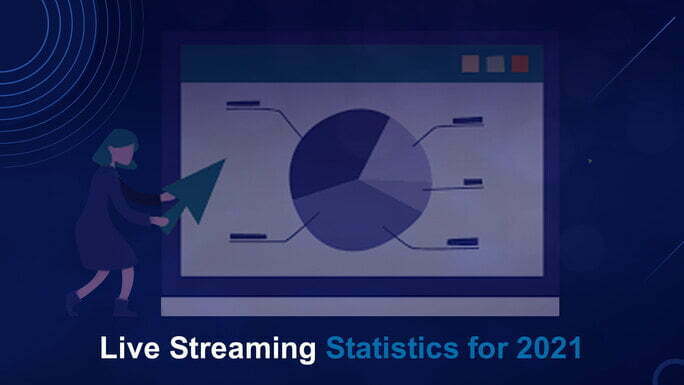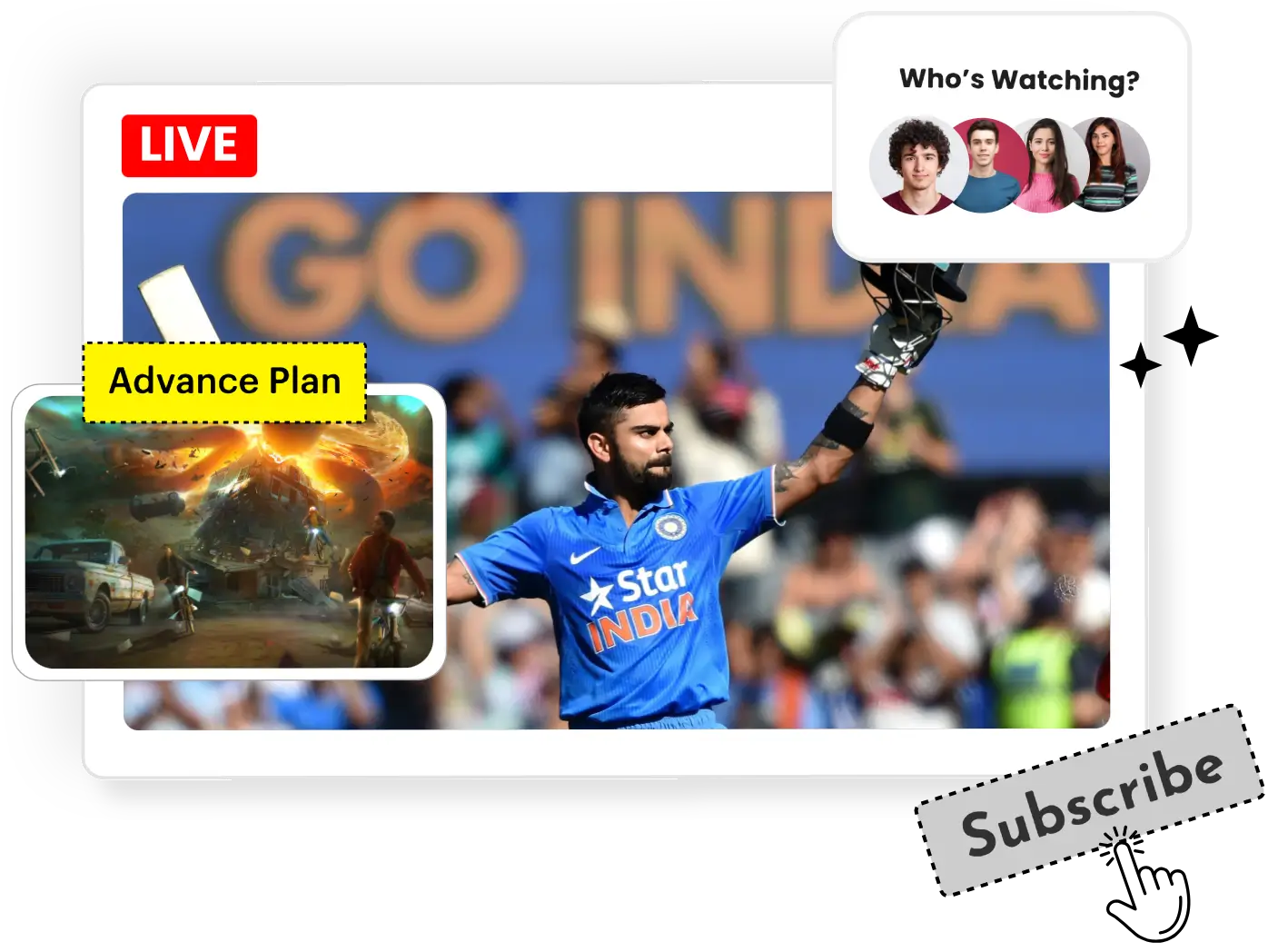Analyzing live streaming statistics for 2021? In this blog, we’re clearing the appropriate statistics ready. We may not have to satisfy you with the popularity of live streaming. If you’re here on the webnexs website it would look like you’re on the proper side of things already. But it’s valuable to analyze the current state of aspects periodically by glancing at industry statistics. Statistics instruct us where we’ve stood, where we’re taking off, and what we should be on the lookout for someplace down the road. If you’re as intense about live streaming as we are, the stats below will be of profit to you as well.
Separately, the subsequent live streaming statistics are fascinating, but together, they confess a story: Live streaming is here to stay, and we can’t stay to see what arises next.
The Advance rise of Live Streaming in 2021
1. Live streaming is rising fast. One document, for the model, exhibits that “Live video evolved by 94%, with a regular viewing time of 26.4 minutes per second.” (Streaming Media, 2019)
2. The live music event with the massive live viewership occurred at 2019 Coachella at about 82.9 million live views. (Variety, 2020)
3. Of all humanity who record that they watch live streams, 7 out of 10 of them tune in to a live stream every day. (Interactive Advertising Bureau, 2018)
4. Live videos keep users’ awareness 10-20x longer than pre-recorded, on-demand topics. (Forrester, 2017)
5. Video streaming rose 72.3% between Q1 2018 and Q1 2019. (Streaming Media, 2019)
6. Millennials are the biggest group of customers of live content. 63% of the community ages 18-34 are observing live-streaming content regularly. (Neil Patel, 2018)
7. The live streaming enterprise is predicted to be valued at 184.27 billion USD by 2027. (Tech Jury, 2020)
8. The online live streaming enterprise has risen 99% between April 2019 and April 2020. (Tech Jury, 2020)
9. Almost 34% of Generation Z ( between 1997 and 2015) have exhibited a new interest in live streams, particularly on social platforms. (GWI Flagship Report 2020)
10. Newer generations (Gen Z and Millennials) utilize more time streaming, whereas aged people (Boomers and Gen Xers) watch more broadcast TV. (GlobalWebIndex)
11. Passage to exclusive coverage is the justification why 26% of viewers tune into live streams. (GWI Consumer Trends Report 2019)
12. Experts also predict that 79% of mobile users will be for streaming video by 2022. (Cisco, 2021)
13. Experts predict that 82% of internet usage will be for streaming video by 2022. (Cisco, 2021)
Read More: Video on Demand (VoD) Market is Expected to Reach USD 175 Billion by 2026
Live Video Streaming Statistics for Business
1. As of 2019, 54% of industries are now utilizing live video for their business or division-wide broadcasts. (Haivision, 2019)
2. 76% of workers have sustained problems like buffering while streaming live video at the job. (Streaming Media, 2018)
3. The top 3 challenges overlooked by business streamers include: live streaming to employees functioning remotely (40%), live streaming from isolated locations or discussion centres (39%), and regulating bandwidth in their establishments (36%). (Haivision, 2019)
4. 64% of industries monitored said they live-streamed to many locations. (Haivision, 2019)
5. 52% of enterprises stream or broadcast live video in their company at least once a week, with 28% using it every day. (Haivision, 2019)
6. 81% of Enterprise live streamers exhibit their live video streams or broadcasts on laborer desktops. 64% exhibit on mobile devices or smartphones, while 31% use a variety of TVs and screens with set-top boxes. (Haivision, 2019)
7. Nearly 80% of marketing experts say that video content is becoming more important in the business world. (4CInsights, 2019)
8. Live video movements boost video engagement by redoubled as much for influencer marketing. (RhythmOne, 2018)
9. Almost a section of marketers have reported that live streaming is the most powerful tool for promoting trade concerts. (The Social Effect, 2019)
10. Two-thirds of marketers that target customers utilize live streaming for marketing. (Content Marketing Institute, 2020)
11. Brands are expected to invest more than $100 billion in video content by 2023. (Forrester, 2018)
12. Video marketers utilize video content to decrease the requirement of support calls. There are reports that support calls have decreased by 44% thanks to videos. (Wyzowl, 2021)
13. In 2020, Facebook Live became a significant portion of marketing strategies where video content was already being used. This increase was about 33%. (Wyzowl, 2021)
Streaming Statistics for Live Events
Live Event Streaming
1. Main events are a big draw for live streaming. The US saw a 218% spike in live news viewership with the midterm election, and the World Cup hoisted overall global traffic up by 28%. (Conviva, 2018)
2. 66% of live video spectators are further likely to purchase a ticket to a show or event after watching a live video of that event or a related one. (Amp. Live, 2017)
3. Breaking news constructs 56% of most-watched live content. Conferences, orators, shows, and celebrations are the other most popular type of content at 44%. (Livestream, 2018)
4. Sporting events report for 87% of live-streamed content. (99 Firms, 2019)
5. Half of sports broadcasters say that latency presents a challenge when streaming real-time sports events. (Digital TV Europe, 2019)
Where COVID-19 Supercharged Live Streaming
The COVID-19 pandemic has affected virtually every industry you can think of. It’s altered the way we learn, exercise, watch, and celebrate the culture.
Here are the important COVID-19 live streaming statistics, that give a significant understanding of how the industry has altered in just a few short months…
- Surveys for live streaming platforms increased by 3x-5x from before March 2020 (pre-COVID) and after March 2020 (During the COVID-19 outbreak) (Google Trends)
- Watch time for live content is up 255% (Think with Google).
- 45% of Brazilians used smart TV and media streaming assistance due to the COVID-19 pandemic. (GlobalWebIndex)
- 11% of Japanese reviewed turned to smart TVs and mobile devices in March 2020. (GlobalWebIndex)
- In March 2020, 23% of people in the U.S. and U.K. inaugurated streaming more live video since the explosion, with 26% being male and 16% being female. (GWI coronavirus Research March 2020)
- 20.5% of survey respondents want to see theatre exhibits published via live stream, while 42% want more live music shows and sports events. (GlobalWebIndex)
- 50% of customers in maximum countries spent time watching news coverage from residence. (GlobalWebIndex)
- Time using messaging apps, social media, and watching SVOD content accumulated by more than 21% globally. (GlobalWebIndex)
- Boomers and Gen XS watched more broadcast TV, while Gen Zs and Millennials spent extra time streaming. (GlobalWebIndex)
- Mid-March of 2020 saw rises of 45% in streaming time. (Digital TV Europe)
- Lockdowns evidence to an increase of 60% in streaming during job hours in Spain. (Diario Jaén)
- From January to March 2020, SVOD viewing in the US rose by 41% on average, varied from the previous months. (Reel good)
- The number of paid subscription video-on-demand (SVOD) users worldwide is calculated to grow to 48 million by the end of 2020. (Digital TV Europe)
- 69% of U.S. Disney Plus spectators who practiced social distancing increased their usage of the platform, while Netflix and Hulu user viewing grew by 65% in March 2020. (nScreenMedia)
- Time spent streaming TV and video grew by more than 41% in Austria and Spain, and by 32% in Germany during the weekend of March 13 to 15, 2020. (Bloomberg)
- 80% of U.S. families watch ad-supported and paid streaming services, compared to 75% who say they did so 6 months ago. (Think with Google)
- Free calling and messaging app Line produced approximately $6.79 million in June 2020 in the Apple App Store.
- 28% of people in the U.S. and 22% in the U.K. conveyed interest in seeing live streaming virtual accomplishments during the coronavirus disruption (GWI coronavirus Research March 2020)
- 26% of U.S. and U.K. respondents would like to watch more DJ sets live streamed. (GWI coronavirus Research March 2020)
- Health and fitness verticals saw the most rapid live-streamed videos, with over 1300% increase in minutes live-streamed, between March to August 2020.
Read more : Video on Demand Market – Growth, Trends, and Forecasts (2020 – 2025)
Live Video Streaming Statistics for marketing
- Almost 3/4 of millennials report that videos are useful when they are distinguishing products while online shopping. (TechJury, 2020)
- 43. 34% percent of marketers use live video. This is a growth of 20% year on year. (Mediakix, 2019)
- In 2018, 60% of spectators conduct online explorations while watching a live stream. (Neil Patel, 2018)
- Animoto’s Social Video Forecast recommends that 76% of marketers and secondary business owners are discovering results with video marketing. (Animoto, 2016)
- 79% of marketers say live video stimulates a more true interaction with an audience. (Go-Globe, 2017)
- 61% of marketers say an advantage of live streaming video is that it develops content that can be viewed or repurposed later. (Go-Globe, 2017)
- 60% of marketers tell the benefit of live video is receiving real-time audience feedback. (Go-Globe, 2017)
- 82% of viewers say they choose to see a live stream instead of a brand’s social posts. (Tech Jury, 2020)
Conclusion
2021 was an engaging year for live streaming, signified by its tremendous development thanks to the COVID-19 pandemic. These live streaming statistics help your Businesses that are looking for a way to connect with their audience to start incorporating live streaming and on-demand video content into sales, marketing, training, and more. As we look to 2021, the possibility to use live video presents tons of opportunities. But to stand out, you must deliver genuine quality content, immersing, and renovates your brand into a broadcaster with an impactful statement designed to empower audiences


